| Home |
| Acknowledgments |
| Conventions |
| Glossary |
| Maps |
| References |
| Links |
| Articles |
| Thumbnails |
| Species
list |
| Family |
| Next
species |
Additional Photos
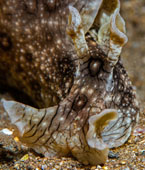
front

underside

interior
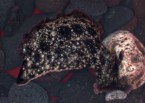
dark
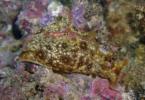
light
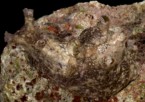
without rings
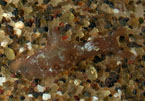
young, 4.5 mm
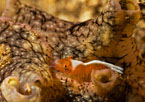
with shrimp
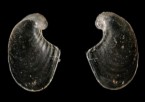
young shell

egg masses
_______________
GALLERY

Aplysia argus Ruppell & Leuckart, 1830
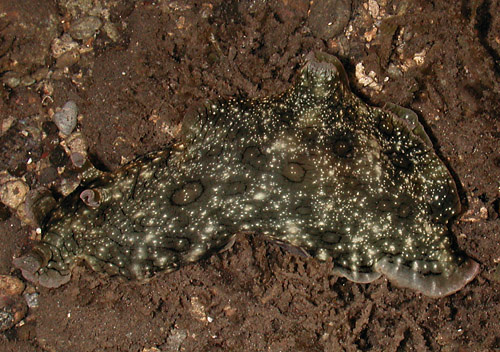
| Maximum size: about 300 mm. (Note 1) Identification: This is a large, dusky gray to light brown sea hare dusted with white flecks and with anastomizing brown lines that may form irregular rings on the sides of the parapodia. The rings appear to become less prominent with increasing age and may be absent in large animals. (Note 2) The edges of the parapodia, rhinophores and oral tentacles are usually pale violet. The siphon is asymmetrically folded. Natural history: Aplysia argus is a common species found in tide pools and shallow rocky habitats at depths of < 1 to 2 m (< 3 to 6 ft). Rarely, it can be found in Halimeda kanaloana beds to depths of 10 m (33 ft). It's nocturnal and conceals itself under rocks during the day where it can often be seen in pairs near its egg masses. Rarely, it may rest in the open during the day at more exposed sites. When disturbed, it ejects bright purple mucus. It lays a tangled, light brown to greenish, spaghetti-like egg mass that is attached to the underside of a rock. Distribution: Big Island, Maui, Lanai, Molokai, Oahu, Kauai, French Frigate Shoals, Laysan, Midway and Kure: widely distributed in the Indo-Pacific. Taxonomic notes: It's listed as Aplysia dactylomela Rang, 1828 in Kay, 1979; Bertsch & Johnson, 1981; and Hoover, 1998 & 2006 (corrected in 2019 printing) as well as most other sources. (Note 3) It's referred to as the "white-speckled sea hare" in Hoover, 1998 & 2006. It was first reported from Hawaii in Pease, 1860 (as Syphonota grandis) and is listed as Tethys grandis in Edmondson, 1946 and Ostergaard, 1950. Alexander & Valdés (2013) consider Aplysia pulmonica Gould, 1852 to be a synonym (originally referring to the color form without well-defined rings). Photo: CP: Hekili Point, Maui; April 10, 2009. Observations and comments: Note 1: Tatiana Gonnason reported an animal from Maui (seen on Aug. 18, 2020) that she estimated as a "conservative:12-14 inches" (305-356 mm) in length. Comparison with slate pencil urchins in her video provides rough support for that length. Note 2: All animals we've seen from Kauai and the Leewards lacked well defined rings. However, we've also seen photos of "ring-less" animals from the Big Island and the observed specimens from Kauai were all relatively large. Note 3: Alexander & Valdés (2013) restricted Aplysia dactylomela Rang 1828 to the Atlantic based on DNA evidence with Aplysia argus Ruppell & Leuckart, 1830 being the next available name for the Indo-Pacific population. |
| Thumbnails |
Species
list |
Family | Next species | Top |